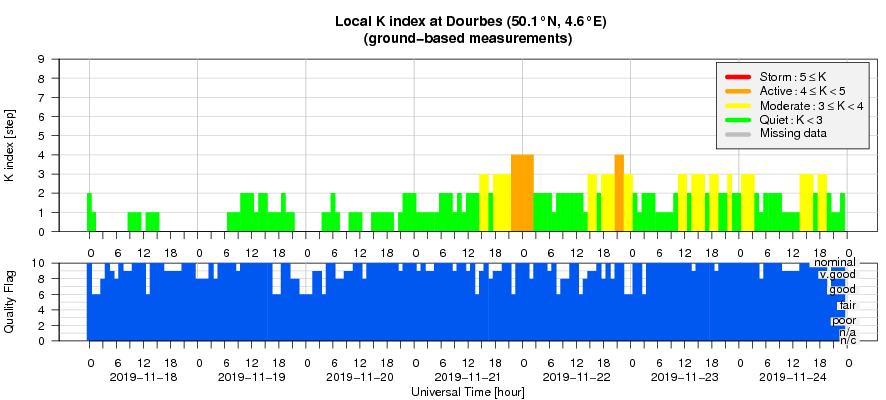- Table of Content
- 1.Looking for a ...
- 2.Do you want to...
- 3.Review of sola...
- 4.PROBA2 Observa...
- 5.The internatio...
- 6.Geomagnetic Ob...
- 7.The SIDC space...
- 8.Review of iono...
2. Do you want to become a PROBA2 Guest Investigator?
3. Review of solar and geomagnetic activity
4. PROBA2 Observations (18 Nov 2019 - 24 Nov 2019)
5. The international Sunspot Number by SILSO
6. Geomagnetic Observations at Dourbes (18 Nov 2019 - 24 Nov 2019)
7. The SIDC space weather Briefing
8. Review of ionospheric activity (18 Nov 2019 - 24 Nov 2019)
Looking for a new colleague
If the words "solar observations" and "simulations" trigger your attention and you have a PhD in Mathematics, Physics, Astronomy, you might want to have a look at: https://tinyurl.com/su8cwbt
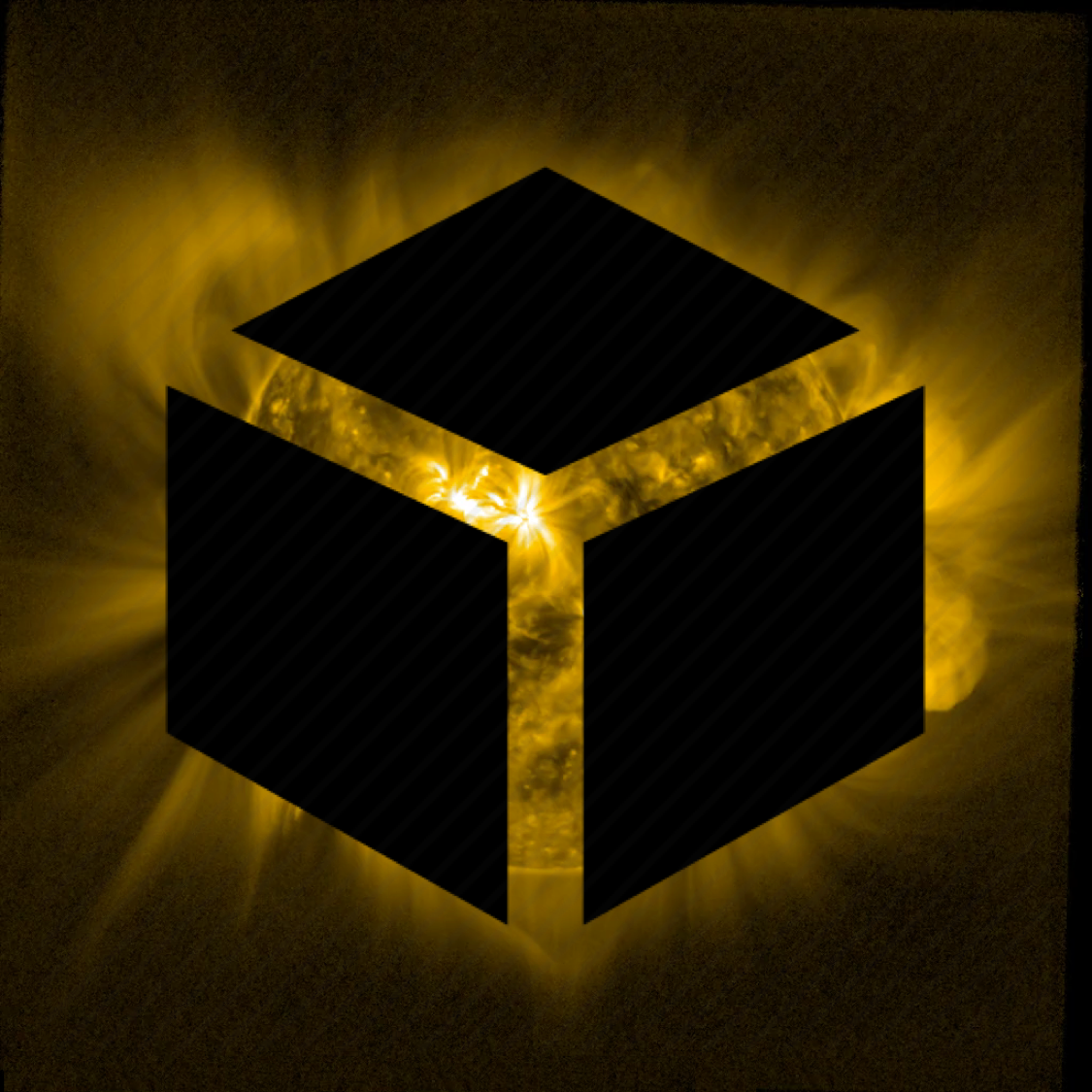
Give it a try!
Do you want to become a PROBA2 Guest Investigator?
Dear Colleagues
Due to a recent surge in interest in the PROBA2 Guest Investigator program, following the summer conference season, the proposal submission deadline has been extended to 2020-Jan-05 (23:59 CET). Those who have already submitted a proposal may re-submit their proposal if they wish to work on them more.
The PROBA2 team welcomes research proposals for a ninth round of its Guest Investigator program for research based on SWAP and LYRA data analysis by scientists outside the SWAP and LYRA PI-teams. In this round we anticipate funding for around five guest investigators or teams who will visit the PROBA2 Science Center at the Royal Observatory of Belgium, in Brussels, between January 2020 and January 2021.
Selected proposers will be invited to spend a few weeks with the PI teams to obtain expert knowledge on the instruments, to participate in the daily commanding of the SWAP and LYRA instruments according to the needs of their data analysis proposal, and to conduct their research. Guest investigators may be reimbursed for travel, accommodation and living expenses. Limited support to present the results at an international conference (during the visit at P2SC) can also be considered.
During the selection process, special consideration will be given to young scientists and PhD students, collaborative research teams with members from more than one research institute (funding above the 5000 euro level may be approved for such teams), and to proposals addressing research topics to which SWAP and LYRA are particularly well-suited.
More details about the application process can be found here: https://proba2.sidc.be/NinthGICallExtended
or by emailing swap_lyra@oma.be
Deadline: Proposals must be received by 2020-Jan-05 (23:59 CET)
Matthew J West on behalf of the PROBA2 team
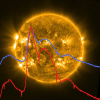
Review of solar and geomagnetic activity
SOLAR ACTIVITY
The solar activity has been at very low level. The Sun was spotless. The X-ray flux remained below the B-level. No earth-directed coronal mass ejections (CMEs) have been observed in the available coronagraphic imagery. The greater than 10 MeV proton flux was at nominal values.
left top: Solar X-ray flux measured by GOES-satellites - left bottom: proton flux measured by GOES-satellites - right: CACTus CME detections based on SOHO/LASCO-imagery.
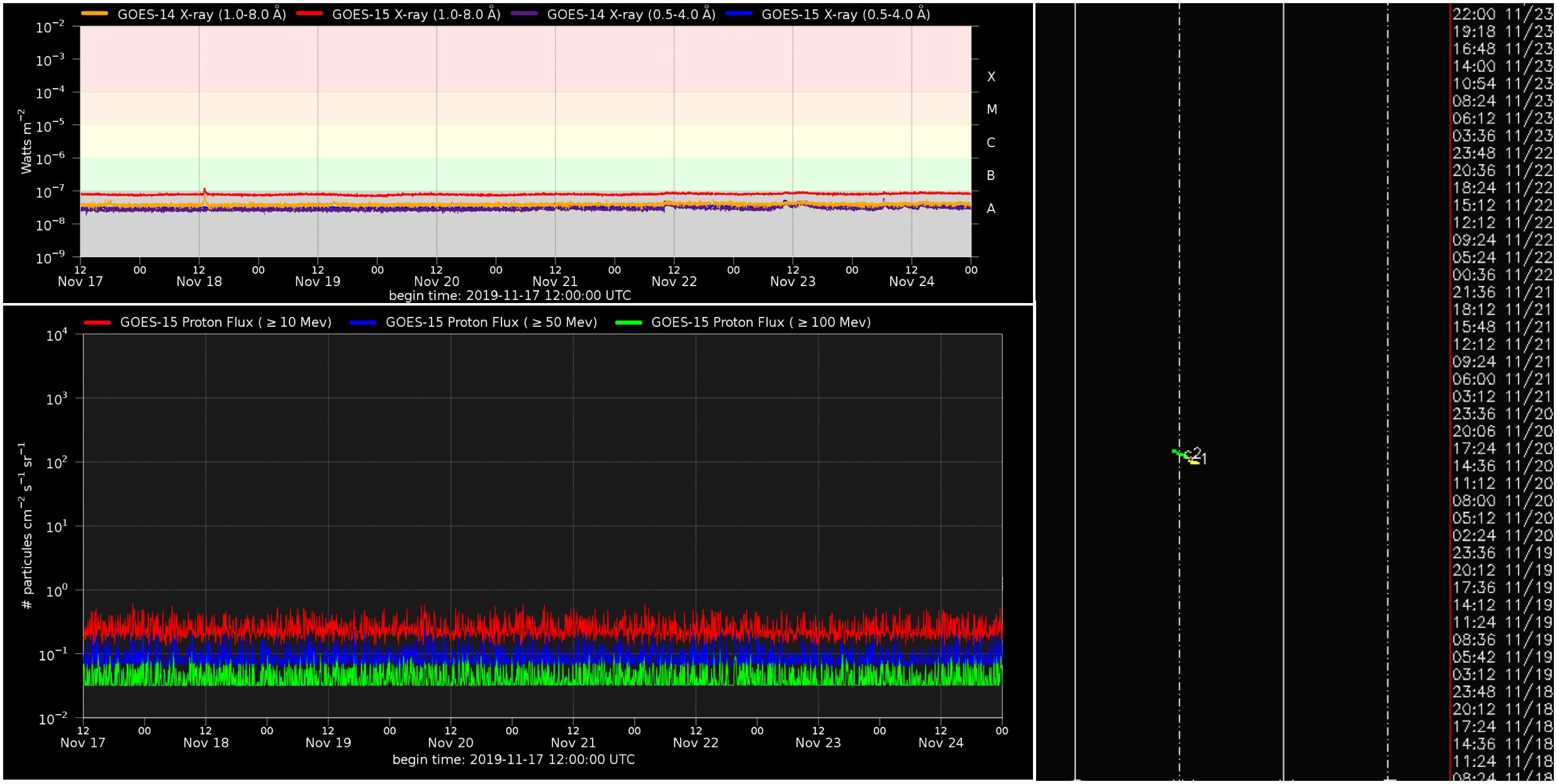
GEOMAGNETIC ACTIVITY
At the beginning of the week the solar wind speed was at background levels, before increasing on 20-Nov-2019 due to the arrival of a high speed stream (HSS) from a small low latitude positive polarity Coronal Hole. The speed peaked between 21-Nov and 22-Nov, reaching speeds of 650 km/s before slowly declining. The total magnetic field also peaked at 12 nT on 21-Nov and the Bz fluctuated between -7 and +7 nT.
Solar wind parameters by ACE, located in the L1 point.
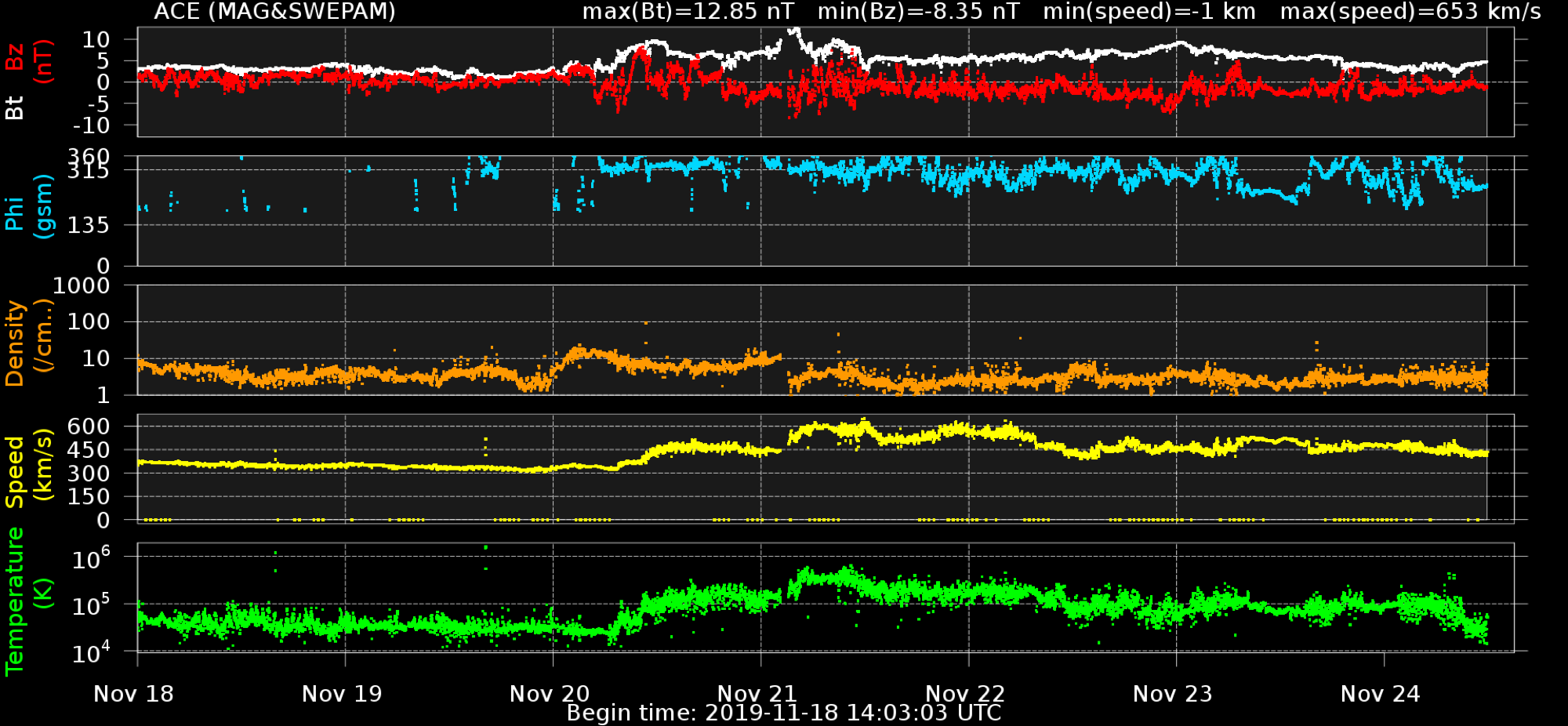
Geomagnetic conditions were mostly quiet. Short periods of active conditions (K/kp=4) were experienced on 22-Nov and 23-Nov, and were observed in response to the solar wind enhancements from the above mentioned HSS.
PROBA2 Observations (18 Nov 2019 - 24 Nov 2019)
Solar Activity
Solar flare activity remained very low during the week.
In order to view the activity of this week in more detail, we suggest to go to the following website from which all the daily (normal and difference) movies can be accessed: http://proba2.oma.be/ssa
This page also lists the recorded flaring events.
A weekly overview movie can be found here (SWAP week 504): https://proba2.sidc.be/swap/data/mpg/movies/weekly_movies/weekly_movie_2019_11_18.mp4
Details about some of this week's events can be found further below.
If any of the linked movies are unavailable they can be found in the P2SC movie repository here: http://proba2.oma.be/swap/data/mpg/movies/
Wednesday Nov 20
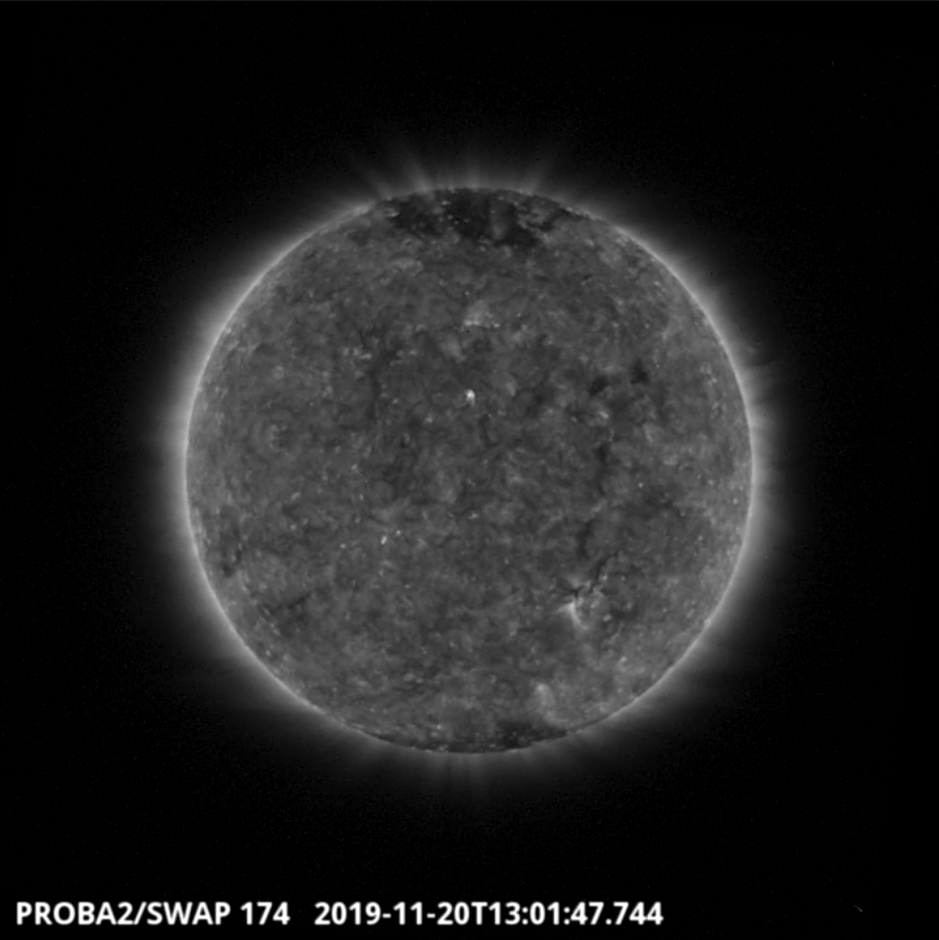
A small filament eruption was observed by SWAP on 2019-Nov-20, visible in the north-west of the solar disk.
Find a movie of the event here: http://proba2.oma.be/swap/data/mpg/movies/20191120_swap_movie.mp4 (SWAP movie)
Sunday Nov 24
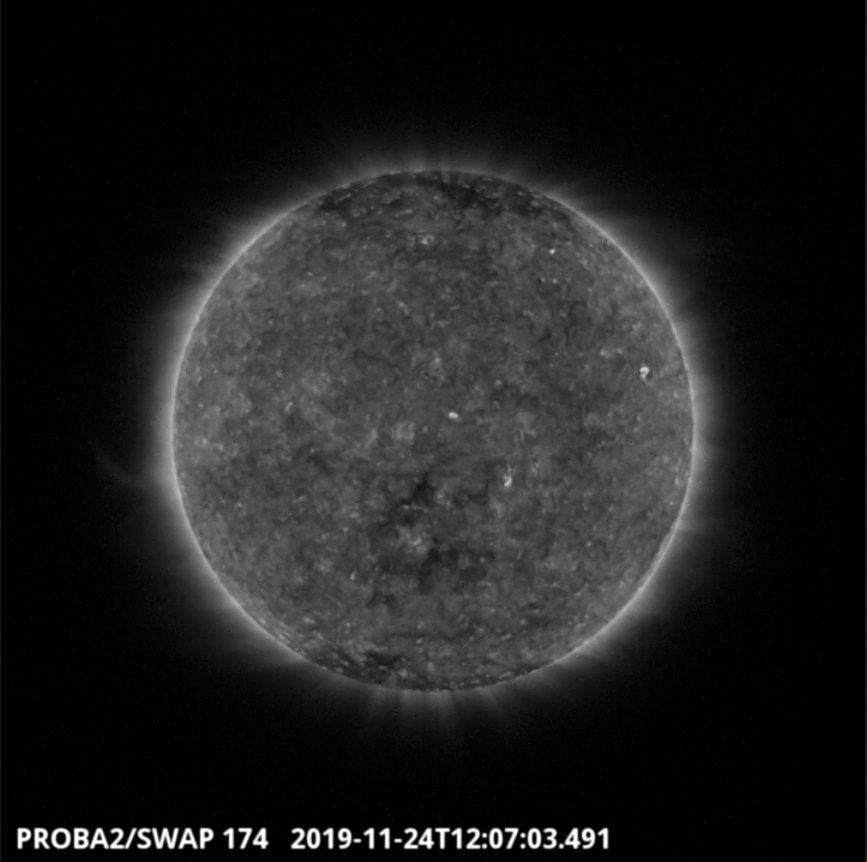
An extended structure off the east limb of the solar disk exhibiting outward flows was observed by SWAP on 2019-Nov-24.
Find a movie of the event here: http://proba2.oma.be/swap/data/mpg/movies/20191124_swap_movie.mp4 (SWAP movie)
The international Sunspot Number by SILSO
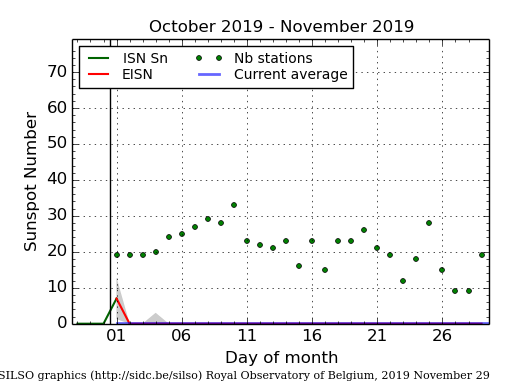
The daily Estimated International Sunspot Number (EISN, red curve with shaded error) derived by a simplified method from real-time data from the worldwide SILSO network. It extends the official Sunspot Number from the full processing of the preceding month (green line). The plot shows the last 30 days (about one solar rotation). The horizontal blue line shows the current monthly average, while the green dots give the number of stations included in the calculation of the EISN for each day.
The SIDC space weather Briefing
The Space Weather Briefing presented by the forecaster on duty from Nov 17 to 24. It reflects in images and graphs what is written in the Solar and Geomagnetic Activity report.
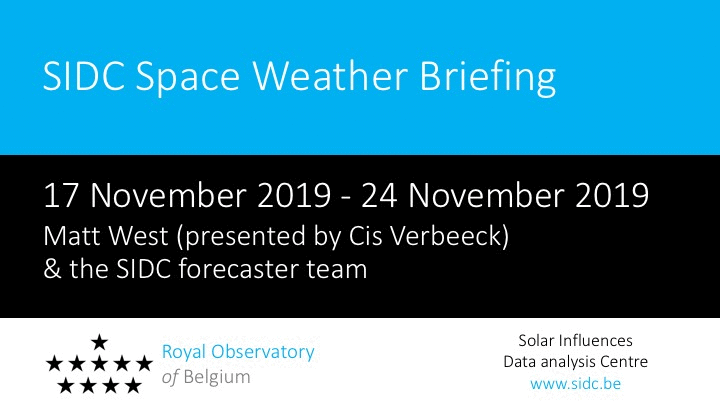
The pdf-version: http://www.stce.be/briefings/20191125_SWbriefing.pdf
The automatically running presentation: http://www.stce.be/briefings/20191125_SWbriefing.ppsm
Review of ionospheric activity (18 Nov 2019 - 24 Nov 2019)
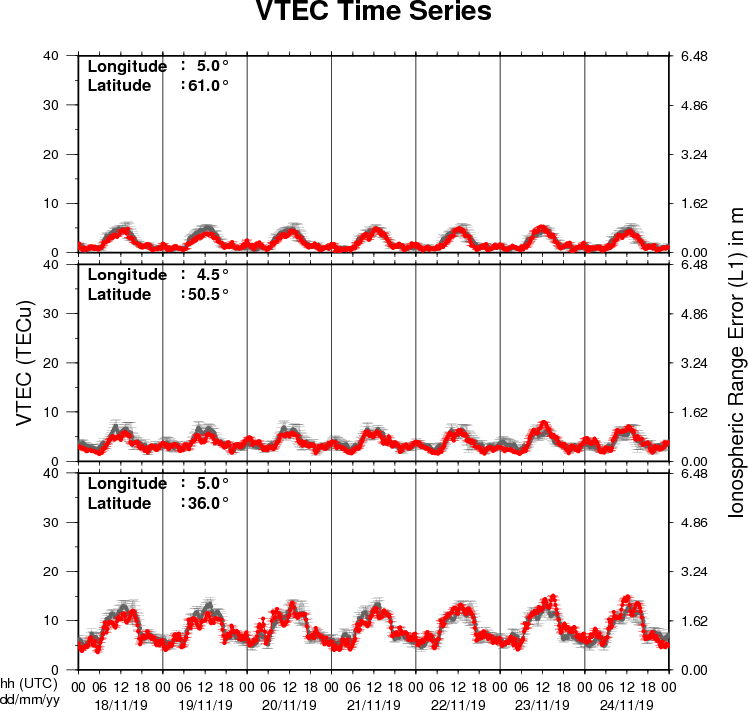
The figure shows the time evolution of the Vertical Total Electron Content (VTEC) (in red) during the last week at three locations:
a) in the northern part of Europe(N61°, 5°E)
b) above Brussels(N50.5°, 4.5°E)
c) in the southern part of Europe(N36°, 5°E)
This figure also shows (in grey) the normal ionospheric behaviour expected based on the median VTEC from the 15 previous days.
The VTEC is expressed in TECu (with TECu=10^16 electrons per square meter) and is directly related to the signal propagation delay due to the ionosphere (in figure: delay on GPS L1 frequency).
The Sun's radiation ionizes the Earth's upper atmosphere, the ionosphere, located from about 60km to 1000km above the Earth's surface.The ionization process in the ionosphere produces ions and free electrons. These electrons perturb the propagation of the GNSS (Global Navigation Satellite System) signals by inducing a so-called ionospheric delay.
See http://stce.be/newsletter/GNSS_final.pdf for some more explanations ; for detailed information, see http://gnss.be/ionosphere_tutorial.php
